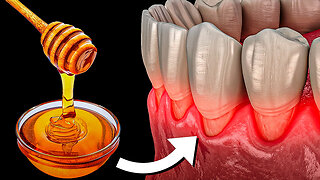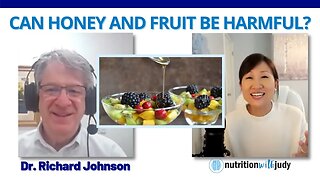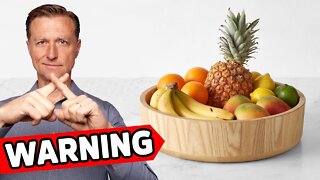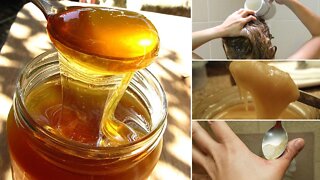Hidden Danger in Fruit and Honey
Hidden Danger in Fruit and Honey
by Dr. Ken Berry
For more health, wellness, and happiness, check out:
https://thelongercrowbar.com
00:00:00 Introduction
I'm Doctor Ken Berry, a family physician with over 20 years of clinical experience. Let's talk about the hidden danger lurking in fruit and honey.
00:01:07 Glycation
Glycation is the non-enzymatic sticking of a sugar molecule, a monosaccharide to either a protein or a lipid. When sugars do this, it gums up the function of your cells and your tissues. When the serum levels of sugar get high enough in your blood, then the sugar just sticks to the protein, sticks to the amino acid. Anytime your blood sugar levels are high, that's a bad thing. Glycation is bad. There's some degree of glycation taking place in every protein and lipid in your body, but as long as it's a very low amount, it’s normal and not a big deal.
00:03:01 Three Kinds of Monosaccharides
When you take a carbohydrate, a starch or any polysaccharide and you break it down into small enough particles, you're gonna wind up with glucose, or fructose, or galactose. These are, by far, the three most common monosaccharides that you can ingest in any version of a human diet. So, sucrose is made up of one glucose and one fructose. Whereas lactose is made up of one glucose and one galactose. But in the end, there are just three monosaccharides that are going to be glycating things inside your body.
00:03:49 HbA1c Test
The test that you can have ordered by your doctor and performed in a lab called a hemoglobin A one C (HbA1c). This looks at the amount of glycation that has happened to the hemoglobin inside your red blood cells. It checks for the amount of glycation in this protein. Fructose is actually eight to ten times more glycating than glucose? That's a lot more glycating than glucose. The simple sugar monosaccharide found in milk is also seven to ten times more glycating than glucose. Fruit and honey are both rich in fructose. I just assumed that the hemoglobin A1C test that measured glycated hemoglobin in your blood, I just assumed that measured all glycation, whether it was from glucose or fructose or galactose, but that's not true, and that's what I found out and that's what I'm gonna share with you. My good friend Barque actually found some research into how the HbA1c test was performed, what it actually did at the molecular level. The hemoglobin A1C only checks for glucose glycation. It cannot see fructose glycation, or galactose glycation, and it also cannot see glycation that happens to your lipids, to the fat molecules in your cells. When the fructose concentration gets high enough in your portal vein or in your systemic circulation, you are glycating the hell out of your cells and tissues and the proteins in the lipids with fructose. But the hemoglobin A1C test is blind to this, and there is currently no test that your doctor can order that looks for fructose glycation.
00:08:55 Direct Enzymatic Assay For %HbA1c
This one research study where they actually did the research that validated the hemoglobin A1C test, it explains how they did it, but I still was not convinced. I emailed one of the researchers and said, "Hey, does the hemoglobin A1C test also check for glycation caused by fructose?" And here's his reply. He says, "Hey, Ken, thanks for your question. Diazyme's enzymatic hemoglobin A1C assay measures the amount of glycated valine at the end terminal of beta chain of hemoglobin. The enzyme used in the assay has a much higher specificity and reactivity towards a ketoamine group formed between glucose. And valine compared with other sugars formed with other amino acids. Hope this answers your question. Best regards, Chong.”
00:09:48 Further Research
Another research study says, "The popular clinical methods used for glucose glycation do not detect the Heyns product or other fructose-mediated adducts. This has compromised research on the potential role of fructose glycation in the pathogenesis of chronic disease in humans." And I found this statement in another study. "Fructose has not been a main focus of glycation research because of the difficulty in measuring its adducts, and, more importantly, because although it is ten times more reactive, aka glycating, than glucose, its plasma concentration is only around 1% of that of glucose." Unless you're eating a diet filled with fruits and honey.
00:10:39 Conclusion
You cannot use the hemoglobin A1C test as a marker for global glycation. It only checks for glucose glycation, it does not see any glycation that happens even from glucose with regards to lipids in your bloodstream. It also is completely blind to any glycation caused by fructose, the sugar in fruit, or galactose, the sugar in milk. If you know someone who's eating a diet full of fruit and honey, please consider sharing this video with them.
Hidden Danger in Fruit and Honey
by Dr. Ken Berry
-
 8:35
8:35
THE HEALING POWER
4 months agoAvoid Honey if you Have These Health Problems
35 -
![Hidden Danger in Fruit & Honey [ A1c Misses Fructose Damage ] 2022](https://hugh.cdn.rumble.cloud/s/s8/1/x/a/m/f/xamfh.0kob-small-Hidden-Danger-in-Fruit-and-.jpg) 11:52
11:52
Dr Berry's Proper Human Diet
1 year ago $0.04 earnedHidden Danger in Fruit & Honey [ A1c Misses Fructose Damage ] 2022
8515 -
![🥜HEALTH NUTS and Nuts You should [Avoid]](https://hugh.cdn.rumble.cloud/s/s8/1/1/s/4/1/1s41p.0kob-small-HEALTH-NUTS-and-Nuts-You-sh.jpg) 7:40
7:40
HealthyFocus
3 months ago🥜HEALTH NUTS and Nuts You should [Avoid]
54 -
 3:02
3:02
Nutrition with Judy
2 years agoCan Fruit and Honey be Harmful? - Dr. Richard Johnson
18 -
 5:03
5:03
Dr. Eric Berg
1 year agoYou May Never Eat Fruit Again after Watching This
2541 -
 3:36
3:36
Natural Cures
1 year ago $0.01 earnedThis Is Perhaps The Healthiest Fruit On Earth
164 -
 11:39
11:39
Just In Health
3 years agoIs Fruit Bad For You - The Truth About Fructose
50 -
 10:07
10:07
Dr. Eric Berg
2 years agoThe #1 Worst Ingredient in the World (HIDING IN YOUR FOODS)
281 -
 3:48
3:48
SAC Best Supplements
1 month agoRegular vs Raw vs Manuka Honey 😳 Shockingly Unhealthy ...
161 -
 4:05
4:05
Natural Cures
7 years ago $0.01 earned7 Surprising Uses for Honey
119